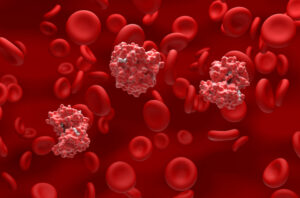Repeat blood donors are at risk of developing iron deficiency. Premenopausal women lose, on average, 60% of their total iron stores with each blood donation, and men lose about 30%. All blood centers monitor donor hemoglobin levels, and circulating ferritin levels are increasingly used to assess iron stores. However, there is no clear consensus on the ferritin concentration needed for hemoglobin recovery; recommendations range from 12 to 50 ng/mL. A recent study examined the association between ferritin levels and change in hemoglobin levels in over 1 million blood donors from four countries—The Netherlands, South Africa, England, and the United States—where minimum donation intervals range from 56 days (for males) to 122 days (for females). By plotting hemoglobin change from a reference point (either the first donation or after a two-year donation interval) to follow-up donations against log10-transformed ferritin levels, researchers observed a consistent two-phase pattern. At lower ferritin levels, hemoglobin changes decreased linearly (with slopes ranging from 0.97 to 2.74 g/dL), followed by a plateau at a “change point” (18.6 to 43.6 ng/mL), where hemoglobin change stabilized and the slope approached zero. The change point helps to identify the threshold for ferritin levels that are necessary to maintain hemoglobin levels after a donation. The change point, however, varied by sex and country underscoring the need for personalized donor management strategies.
Reference:

